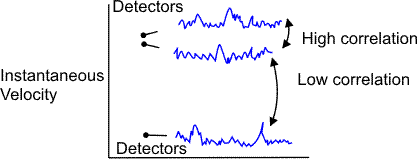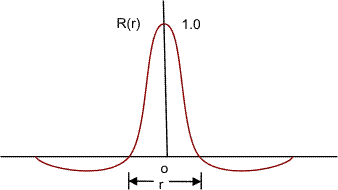Correlation Functions
Turbulent motion is by definition: EDDYING MOTION

Figure 4.1
A statistical correlation can be applied to fluctuating velocities in turbulence. A high degree of correlation exists between the velocities at two points in space, if the distance between the points is smaller than the diameter of the eddy. Converse is also true.
Consider a random variable (velocity) at two points, separated by a distance r. An Eulerian correlation tensor at the two points can be defined.
In other words, the dependence between the two velocities at two points is measured by the time averages of the products of the quantities measured at two points. The correlation of the  components of the turbulent velocity of these two points is defined as components of the turbulent velocity of these two points is defined as
The non-dimensional form of the correlation
The value of R (r) of unity signifies a perfect correlation of the two quantities involved and their motion is in phase. Negative value of the correlation function implies that the time averages of the velocities in the two correlated points have different signs.

Figure 4.2
The Figure (4.2) shows typical variations of the correlation R with increasing separation r .
To describe the evolution of a fluctuation  , we need to know the manner in which the value of , we need to know the manner in which the value of  at different times are related. For this purpose the correlation function between the values of at different times are related. For this purpose the correlation function between the values of  at different times is chosen and is called autocorrelation function. at different times is chosen and is called autocorrelation function.
|